|
Books by
Maria Reiche
“Markings: Aerial Views of Sacred Landscapes
by
Maria Reiche
Charles Gallenkamp
Keith Critchlow
Lucy Lippard
(Contributors)
Marilyn Bridges
(Photographer)
Haven O’More
(Preface)
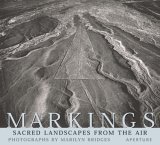
EU English Edition
“Mystery on the desert: A study of the ancient figures and strange delineated surfaces seen from the air near Nazca, Peru”
by
Maria Reiche
Unknown Binding
1949 Edition
“Geheimnis Der Wuste/
Mystery on the desert/
Secreto De La Pampa”
German/English/Spanish
by
Maria Reiche
Hardcover
1968 Edition
“Peruanische Erdzeichen/Peruvian Ground Drawings
German & English
by
Maria Reiche
(Author)
Malcolm G. Leybourne
(Translator)
Dr. Hermann Kern
(Translator)
Hermann Kern
(Foreword)
1974 1st Edition
“Geheimnis Der Wuste/
Mystery on the desert/
Secreto De La Pampa –
Preliminaries for a Scientific Interpretation of the Pre-Histori c Ground-Drawings of Nazca, Peru and Introduction to Their Study“
German/English/Spanish
by
Maria Reiche
Hardcover
1989 7th Edition
Signed by author
Books about the Nazca
lines & geoglyphs
“Maria And The Stars Of Nazca / Maria Y Las Estrellas De Nazca”
Spanish & English
by
Anita Jepson-Gilbert
Rodger Osban
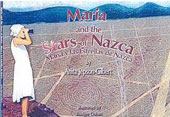
EU English Edition
“Ancient Nasca
Settlement & Society”
by
Helaine Silverman 
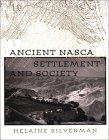
EU English Edition
“Nasca society arose on the south coast of Peru 2000 years ago and evolved over the course of the next 700 years. This text examines the range of sites occupied by the people responsible for some of the most exquisite art and ingenious hydraulic engineering of the pre-Columbian world.
“The Nasca
(Peoples of America)”
by
Helaine Silverman 
&
Donald A. Proulx 

EU English Edition
“Ancient Nasca culture of the south coast of Peru is famous for its magnificent polychrome ceramics, textiles, and other works of art, as well as the enigmatic ground markings on the desert plain at Nasca. In the past two decades much has become known about the people who produced these fascinating works. This scholarly yet accessible book provides a penetrating examination of this important civilization.”
|
|
Probably the best known examples of geoglyphs are the magnificent lines and drawings carved into the desert on the Nazca Plain in Peru – only able to be seen in their fullness from the air. These were discovered in 1939 by Dr. Paul Kosok of Long Island University, who in 1946 handed over all his information about these amazing geoglyphs on the Nazca Plain to Maria Reiche , a mathematician and graduate of Hamburg University. , a mathematician and graduate of Hamburg University.
Maria Reiche spent the next fifty years living on the Nazca Plain close to the area of the drawings, painstakingly mapping each one, and trying to protect them from the encroaches of modern civilisation. She died aged 95 in Peru in June 1998, and left many feeling that the great Nazca geoglyphs have lost their champion. spent the next fifty years living on the Nazca Plain close to the area of the drawings, painstakingly mapping each one, and trying to protect them from the encroaches of modern civilisation. She died aged 95 in Peru in June 1998, and left many feeling that the great Nazca geoglyphs have lost their champion.
She was laid to rest besides the enigmatic drawings she spent half a lifetime protecting. And, as you will see from some of the aerial photographs, car tracks, horses hoof prints, and even the Pan-American highway have all contributed to the destruction of a number of the drawings. In many respects this has been caused simply by the sheer size of the geoglyphs which can only be appreciated properly from the air. It is the sheer size of the work undertaken by the ancient Peruvians that continues to fascinate all who encounter them, and Maria Reiche explains in her book, “Mystery on the Desert”, the method of construction explains in her book, “Mystery on the Desert”, the method of construction
:
“It seems almost incredible that ground-drawings made by superifcially scratching the surface could have withstood the ravages of time and weather over such long periods. The climate is one of the driest of the globe. One could say that it rains for half an hour every two years. And although strong winds carry great quanitites of sand, not encountering any obstacles on the vast tablelands open towards the north and south, they take it further north, where at seventy miles distance one can see huge dunes on both sides of the Pan-American highway. Moreover, close to the ground the air is becalmed considerably. Owing to their dark color, the surface stones absorb much heat, causing a cushion of warm air to protect the surface from strong winds.
An additional factor contributing to the ground remaining undisturbed for hundreds of years is that the soil contains a certain amount of gypsum which, moistened by daily morning-dew, slightly affixes every stone to its base. This makes it possible to retrace the steps by which the ancient topographers laid out the accurate shapes of their complicated structures, having used stones as markers which have remained in the same place where they were put when the drawings were made. It was found, for example, that the huge regular curves of animal-figures were composed of segments of circles, whose centres were marked by a stone which had been, or was cut to, one hundredth of the the corresponding radius.”
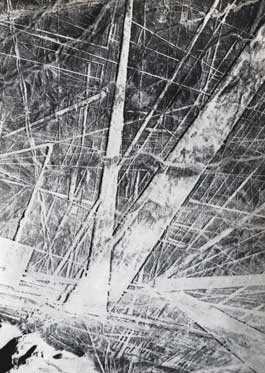
Copyright © 1997, Maria Reiche
The remarkable degree of precision with which the Nazcans surveyed and constructed the drawings, lines and trapezoid figures is astounding. Many of these shapes overlap each other in a manner that seems intitially random, but which when looked at more closely can be seen to be very much by design. The aerial photograph to the left below was taken from a helicopter many hundreds of feet up in the air. It is an oblique view, and can give an idea of the sheer vastness of the endeavour undertaken by the ancient people of Nazca.
The lines and trapezoidal shapes shown here radiate from the border of the Ingenio Valley, which has been intensely cultivated over millennia by the peoples of the region.
An oasis between the desert and the sea, it is now occupied by huge single-crop plantations, which still use the same irrigation ditches that were dug before the arrival of the Spaniards.
“The geometric drawings give at closer inspection the impression of a cipher-script, in which the same words are sometimes written in huge letters, at another time in minute characters. There are line-arrangements which appear in a great variety of size categories together with very similar shapes.
All drawings are composed of a certain limited number of basic elements, which between them show a certain range of variation. Even when equal in size, there are, as in living beings, never two the same.”
The sophistication of the Nazca topographers, as Maria Reiche referred to them, is indeed astounding. Just to have constructed these magnificent geoglyphs is an achievement in itself. But Maria Reiche found an even greater consideration that appears to have been incorporated into the design layout of the whole scheme – astronomical orientation.
The apparently random way in which straight lines of varying width criss-cross other drawings seems at first to have no signifigance. Given the long periods of occupation of the area going back several millennia, it would not be unusual to find later drawings laid on top of earlier geoglyphs, and in many place this appears exactly the case. But in other cases Maria Reiche found other possible explanations:
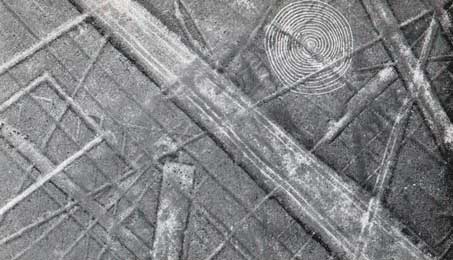
Copyright © 1997, Maria Reiche
“The marvellous regularity of two spirals of which one runs inside the other was produced by winding two ropes, 150 and 130 feet long, around three posts forming a triangle.
A smaller double spiral was found among a maze of lines. The line pointing to its border, which was cleaned for the photograph, could have been constructed for solstice observations.”
The astronomical considerations suspected by Maria Reiche during her 50 years of studying the geoglyphs on the Nazca plain have in many cases since proven to have been accurate. As astronomers begin to apply their knowledge to ancient sites, and as archæologists begin to learn a little astronomy, a greater understanding of the skywatching activities of ancient peoples is emerging. Little wonder, then, that Maria Reiche in her book, “Mystery on the Desert”, quotes the original discoverer of the mysterious lines, trapezoids and geoglyphs at Nazca, Dr. Paul Kosok, as saying that in his opinion they represented:
“the largest astronomy-book of the world”
all quotes on these tribute pages are from
“Mystery on the Desert”
by Maria Reiche
if you would like to support our
astro-archaeology research projects
please send us a book

from our Wish List
|
|
To understand why this News Page is sometimes late here is some information about Fibromyalgia
if you would like to support our
astro-archaeology research projects
please send us a book

from our Wish List
“Pathways to the Gods: The Mystery of the Andes Lines”
by
Tony Morrison
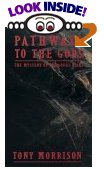
EU English Edition
“Nazca: Eighth Wonder of the World?”
by
Anthony F. Aveni
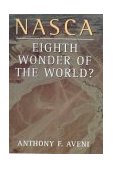
EU English Edition
“Between the Lines: The Mystery of the Giant Ground Drawings of Ancient Nasca”
by
Anthony F. Aveni
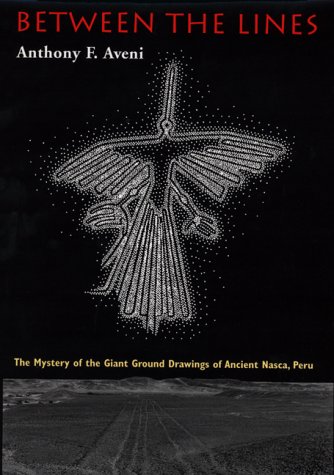
EU English Edition
“The Cities of the
Ancient Andes”
by
Andriana von Hagen
& Craig Morris

EU English Edition
“The largest empire of pre-Columbian America was toppled in under a decade by a handful of Spanish invaders who looted the fabled riches of its greatest city, Cuzco, and severed its 15,000 mile system of roads. But this Inca empire was only the final link in a chain of urban development stretching back to 2500 B.C. How did cities evolve in the ancient Andes?”
Nazca News
more information
about the Nazca lines
& geoglyphs on
:
Landscape Geometry
Lines Over Mountains
Animals & Landscape
Figures On The Plain
The Human Scale
Birds On The Pampa
The Spider Geoglyph
& The Stars Of Orion
Spirals In The Desert
|